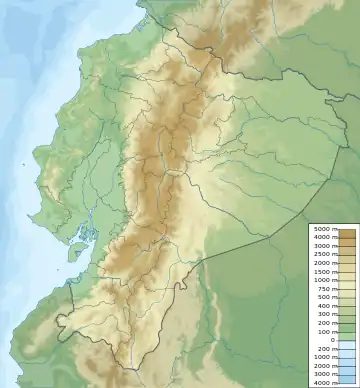Carihuairazo
Mount Carihuairazo (also Carihuayrazo) is an eroded stratovolcano neighboured by Ecuador's highest mountain Chimborazo.
| Carihuairazo | |
|---|---|
 Carihuayrazo left of bigger Chimborazo as seen from the north | |
| Highest point | |
| Elevation | 5,018 m (16,463 ft) |
| Prominence | 620 m (2,030 ft) |
| Coordinates | 01°24′25″S 78°45′00″W |
| Geography | |
 Carihuairazo | |
| Parent range | Andes, Cordillera Occidental |
| Topo map | IGM, CT-ÑIV-C1 |
| Geology | |
| Age of rock | Paleogene (Gomez 1994) |
| Mountain type | Stratovolcano |
| Last eruption | Unknown |
| Climbing | |
| First ascent | 1951 A. Eichler, H.L. Uribe, J. Morawiecki |
| Easiest route | glacier/snow/rock climb AD |
Geography
Location
Carihuairazo is located in the Cordillera Occidental of the Andes of central Ecuador, 150 km (93 mi) south-southwest of the capital Quito. Its neighboured by 6,263 m high Chimborazo. The nearest cities are Riobamba (~30 km to the southeast), Ambato (~30 km to the northeast) and Guaranda (~30 km to the southwest). Carihuairazo's 1.5 km wide heavy eroded caldera opens to the east.
The Carihuairazo forms part of the "Reserva de Produccion Faunistica Chimborazo" which forms a protected ecosystem to preserve the habitat for the andens native camelids Vicuña, Llama and Alpaca.
Glacier
Carihuairazo's Glacier lost almost all of its mass during the last decade as a result of global warming and ash covers caused by the recent volcanic activity[1] of its eastern neighbour Tungurahua. At current rate Carihuairazo's Glacier is expected to completely disappear between 2020 and 2030.[2]
Volcanism
Carihuairazo must have been a Volcano of similar dimensions to its neighbour Chimborazo before explosions during the last period of activity destroyed the mass of the peak, leaving today's caldera. There is no evidence of historic activity and Carihuayrazo is considered inactive.
History
Etymology
An interpretation of its name is that it's a combination of the Quichua words Cari (man), huay (wind) and razu (Ice/Snow) (Schmudlach 2001). Local Indian mythology narrates that Carihuairazo and El Altar which are both volcanic calderas have been destroyed by Taita (Father) Chimborazo fighting for the grace of Mama Tungurahua.
First Ascent
Carihuairazo was climbed by Edward Whymper, the cousins Louis and Jean-Antoine Carrel, and Ecuadorians David Beltran and Francisco Campaña, during their 1880 Ecuador expedition. It is not entirely clear from Whymper's description, but some people believe that they climbed the Mocha (4,960m) and not the Maxim summit (5,018m). The first ascent of the Maxim summit is therefore attributed to Arturo Eichler,[3] Horacio Lopez Uribe and Jean Morawiecki[4] in 1951.[5] Whymper and his companions ascended in cloudy conditions, believing the east peak (Mocha) to be the higher one. When the clouds cleared on their descent, Whymper said they could see they had climbed the west peak. It is likely that he meant the central summit, which is just west of Mocha.[6]
Climbing
Due to the glacier retreat and its consequences climbing Carihuairazo has shifted from a PD glacier route with some rock scrambling to an AD route with a technical climb to the summit tower (Maxima, 5,018m).
- Carihuairazo can be climbed year round with best seasons being December–January and July–August.
- A good height acclimatization is highly recommended for this climb.
- The mountain is contained on the IGM (Instituto Geografico Militar) 1:50000 Map Chimborazo (CT-ÑIV-C1) (IGM 1991, ).
Routes
The normal route to Carihuairazo Maxima (5,018m) starts from a camping spot at ~4,600m, reaching the main ridge either via the SW-ridge or from West via the glacier, followed by a difficult technical climb to reach the summit tower.
References
- Gomez, Nelson (1994). Atlas del Ecuador. Editorial Ediguias. ISBN 9978-89-009-2.
- IGM (Instituto Geografico Militar, Ecuador) (1991). "Chimborazo Ecuador, CT-ÑIV-C1". Archived from the original on 2008-06-27. Retrieved 2008-01-26.
- Neate, Jill (1994). Mountaineering in the Andes. Expedition Advisory Centre. ISBN 0-907649-64-5.
- Schmudlach, Günter (2001). Bergführer Ecuador. Panico Alpinverlag. ISBN 3-926807-82-2.
Notes
- Tungurahua's recent activity period started in 1999 with the most significant eruptions between October and December 1999 and May and July 2006 ("Actividad Volcan Tungurahua". Instituto Geofísico, EPN Ecuador. Archived from the original on 2006-05-01. Retrieved 2006-08-12.)
- "Glaciers & Ice Sheets - World Preservation Foundation". Archived from the original on 2013-05-12. Retrieved 2012-03-19. Article from World Preservation Foundation
- In 1934 Arturo Eichler emigrated for political reasons from Germany to Ecuador, he later became an important ecologist in Venezuela ("Arturo Eichler - Biografia". Fundacion la Era Agricola. Archived from the original on 2007-01-09. Retrieved 2006-08-05.)
- Jean Morawiecki was interim in charge of the French Embassy in Ecuador 1950/51 ("Ambassade". Ambassade de l'Equateur en France. Archived from the original on 2006-07-05. Retrieved 2006-08-05.)
- Neate, Jill. Mountaineering in the Andes: A Sourcebook for Climbers. Royal Geographical Society, 1994, p.24.
- Whymper, Edward. Travels Amongst the Great Andes of the Equator. John Murray, 1892, p.317.